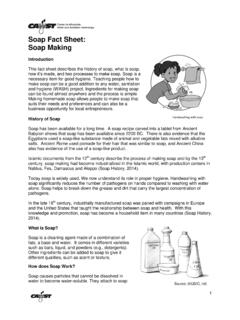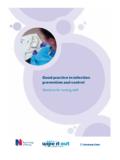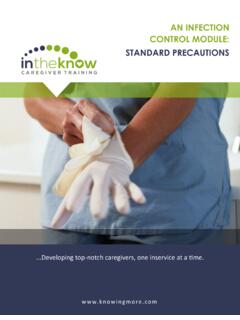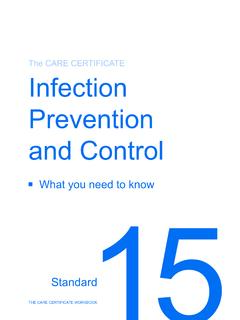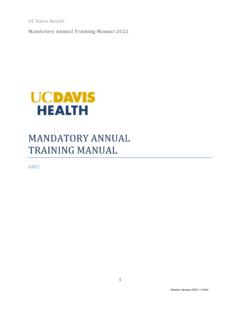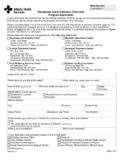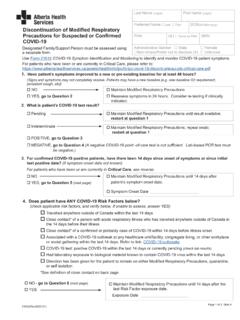Transcription of Fact Sheet: Hand Hygiene in Healthcare Facilities
1 August 2017 Page 1 Fact sheet : Hand Hygiene in Healthcare Facilities Good Hygiene is critical to ensure that Healthcare staff provide quality care, reduce the spread of infections, and protect the health of communities. This fact sheet focuses primarily on hand Hygiene , but recognizes the role of comprehensive Hygiene ; infection prevention and water and sanitation services to achieve a safe, clean Healthcare environment. Key Facts Handwashing with soap is an effective way to prevent infection in Healthcare Facilities . A study of Healthcare Facilities in 54 countries found that 35% failed to offer soap and water for On average, 61% of Healthcare workers are not adhering to best handwashing Each year, Healthcare -associated infections affect of patients in developing countries and antimicrobial resistance leads to 700,000 Effective multi-modal programs can significantly improve hand Hygiene in Healthcare Facilities .
2 Critical Elements of Hand Hygiene in Healthcare Facilities For effective hand Hygiene , all staff in Healthcare Facilities (HCF) must wash or disinfect their hands at 5 critical moments: before patient contact, before an aseptic task, after body fluid exposure risk, after patient contact, and after contact with patient Sanitary gloves and other prophylactic materials must be kept in continuous supply, worn during patient interactions, and safely discarded to reduce the spread of Healthcare staff should also wash their hands when entering or exiting HCFs, before eating, and after using the toilet, and should encourage patients and visitors to do the same. Basic hand Hygiene Facilities are defined by the WHO/UNICEF Joint Monitoring Programme as hand Hygiene materials, either a basin with water and soap or alcohol hand rub, available at points of care and toilets. 6 Good hand Hygiene requires the presence of functional and well-maintained handwashing stations located in or near sanitation Facilities , at main entrances and exits of the Healthcare facility, and in all treatment and recovery wards.
3 The World Health Organization (WHO) recommends a 1:10 sink to bed ratio in Healthcare Facilities and handwashing stations within 5 meters of Sinks or handwashing stations should be designed to make handwashing user-friendly for all staff, patients, and visitors. Healthcare -Related Risks of Poor Hygiene A Healthcare facility without sufficient Hygiene supplies practices cannot provide high quality Healthcare . Clinics around the world face severe challenges to fostering a clean environment for their patients. A study of water, sanitation, and Hygiene (WASH) in HCFs in 54 countries found that 38% did not have an improved water source, 19% lacked sanitation Facilities , and 35% failed to offer soap and water for Failure to observe Hygiene protocol impedes the delivery of safe services, increases the likelihood of Healthcare -associated infections (HCAI), and allows antibiotic-resistant bacteria to WHO found that on average, 61% of Healthcare workers in some Facilities up to 90% do not adhere to best handwashing practices, even when supplies are ,8 Poor Hygiene practices contribute to higher rates of HCAIs, increased risk of antimicrobial resistance (AMR), and the amplified burden on health systems which results from HCAIs and AMR.
4 Healthcare -Associated Infections HCAIs are infections developed during care or treatment in a Healthcare Prevalence in developing countries is estimated at , and averages in ,9 HCAIs prolong recovery time and hospital stays, result in disability, increase medical costs, and pose life-threatening risks for Up to 56% of neonatal deaths among babies born in hospitals are due to infection;4 and poor infection prevention practices place newborns in developing countries at particularly high risk for HCAIs and other Unsanitary conditions, limited availability of hand Hygiene supplies, inadequate medical waste disposal, poor hand Hygiene practices, overcrowding, and insufficient equipment in HCFs foster an environment optimal for the spread of infection. Improved hand Hygiene has been shown to reduce HCAI spread by 40% and full compliance can reduce the risk of acquiring methicillin-resistant staphylococcus aureus (MRSA), a common cause of severe infections in HCFs, by 24%.
5 11,12 August 2017 Page 2 Antimicrobial Resistance Antimicrobial resistance occurs when microorganisms change and become resistant to the drugs used to treat AMR presents an urgent threat to patient safety, and has reduced the efficacy of drugs used to treat HCAIs and illnesses including tuberculosis and Presently, 700,000 deaths each year are attributable to AMR, and it is estimated that by 2050, resistance to antimicrobial treatments will kill 10 million people each By 2030, approximately $700 billion in Healthcare costs will be associated with AMR unless additional investment is Proper hand Hygiene practice at key moments in HCFs can reduce the spread of drug-resistant bacteria and decrease infection rates, leading to lower antibiotic prescription rates. Hand Hygiene interventions have been shown to be effective in reducing resistant infections in hospitals; and one model estimated that each increase of 1% in hand Hygiene compliance could save nearly $40,000 in MRSA-related health care costs per year in a hospital Health Systems & Quality of Care The effects of poor hand Hygiene in HCFs burden health systems and increase resource needs.
6 HCAIs can increase length of stay in hospitals by 5 to nearly 30 days for patients who develop infections during hospital ,18 High HCAI prevalence can generate constraints including overcrowding, medical supply shortages, and reduced staff productivity; these can impose significant costs on health systems. Infections acquired during hospitalization can also incur litigation costs, lost work time, and other unnecessary expenditures that cost some countries as much as $19 billion Low compliance to Hygiene standards compromises the ability to offer safe services. Infection prevention and control (including hand Hygiene ) is a WHO standard for improving quality care for mothers and newborns in Healthcare Lack of Hygiene in HCFs can undermine the trust of a community;18 it also reduces the capacity of authorities to respond to emerging public health crises and the increasing impact of climate change, limiting the resilience of health ,21 Proper hand Hygiene can help stop the spread of disease outbreaks, such as Ebola, while protecting health workers from acquiring or transmitting Improving Hand Hygiene & Healthcare Outcomes Effective multi-modal programs can significantly improve hand Hygiene and sustain compliance in HCFs.
7 For example, the WHO 5 Moments for Improved Hand Hygiene campaign (consisting of system change, training & education, observation and feedback, reminders in the hospital, and a hospital safety climate) was found to improve and sustain hand Hygiene Practical training and behavior change programming for Healthcare providers, and all staff, can improve hand Hygiene practices, particularly when repeated at regular Hand Hygiene is an instrumental part of a comprehensive IPC strategy, which also consists of appropriate clinical practice ( , wound dressing); cleaning of areas used by medical staff to treat patients or administer care; disinfection of medical equipment and supplies; and proper disposal of medical An improved water source facilitates handwashing, and, when Hygiene supplies ( , soap, handrubs, and cleaning products) are available, enables a sanitary environment with clean medical equipment and devices. Recommendations to Improve Hygiene in Healthcare Settings Improving hand Hygiene in HCFs requires sustained action on multiple levels to improve knowledge, competencies, and motivation; supplies and infrastructure; and the enabling policy environment.
8 The strategies listed below stand to contribute to policies, protocols, and targets that prioritize core IPC and Hygiene standards, providing guidance for health systems administrators Healthcare policymakers. Policy Recommendations Establish financing for Hygiene in HCFs that ensures resources support the inclusion of handwashing infrastructure into health facility design and the implementation of IPC strategies and programming. Strengthen monitoring systems and standardize streamlined Hygiene indicators into national health assessments and surveillance to inform, adapt, and validate HCAI reporting mechanisms. Develop and implement Healthcare strategies that recognize the links between the underlying causes and drivers for Hygiene -related behavior change, incorporating key components into HCF programming. Employ accreditation systems to mandate and enforce minimum facility design, construction, and maintenance requirements for HCFs, including handwashing stations at critical points.
9 August 2017 Page 3 Supplies and Infrastructure Recommendations Work with partners, such as the private sector, to develop supply-chains for access to low-cost Hygiene Ensure Hygiene products that prevent germ spread ( , surgical gloves, hand soap or handrub, disinfectants) are available and used in HCFs, and ensure cleanliness of supplies, equipment, and infrastructure. Ensure access to essential Hygiene services and maintain hardware ( , handwashing stations), and guarantee that Facilities are accessible to all users, including people with disabilities. Ensure all HCFs have access to basic WASH Facilities , or advanced Facilities if national guidelines Health Facility Recommendations Implement the five components of the WHO multimodal approach to hand Hygiene improvement based on drivers of hand Hygiene compliance: system change (alcohol-based handrub at the point of care); training and education; observation and feedback; reminders in the workplace ; and a culture of Provide regular, comprehensive training and behavior change interventions on hand Hygiene and IPC to all staff and volunteers working in Healthcare Facilities .
10 Ensure staff have the competencies needed to prevent, monitor, and recognize Integrate core Hygiene compliance as part of a comprehensive IPC approach, and ensure that facility directors and IPC committees have authority to reinforce IPC strategies when HCFs face understaffing, overcrowding, limited supply coverage, and health or environmental crises. Provide patients with information on their right to receive care from a Healthcare worker with clean hands . Encourage Healthcare workers to use effective behavior change approaches and distribute essential products that can promote healthy handwashing behavior within and beyond health settings. Recommended Reading These resources provide further information on improving hand Hygiene in health settings. To learn more and browse additional resources, visit the key topics page on the Global Handwashing Partnership website. Reports & Studies Antimicrobial Resistance: Tackling a crisis for the health and wealth of nations [Link] Financing universal WASH under the Sustainable Development Goals [Link] Progress on Drinking Water, Sanitation and Hygiene : 2017 update and SDG baseline [Link] WASH in Healthcare Facilities : Status in LMICs and the way forward [Link] WASH for Health: Antimicrobial resistance and emerging WASH [Link] WHO guidelines on hand Hygiene in Healthcare [Link] Fact Sheets, Infographics & Webinars Hand Hygiene in Healthcare : The next frontier in international health and development [Link] WASH in Health Care Facilities : Joint action for universal access & improved quality of care [Link] WASH Counts in Healthcare Facilities .
